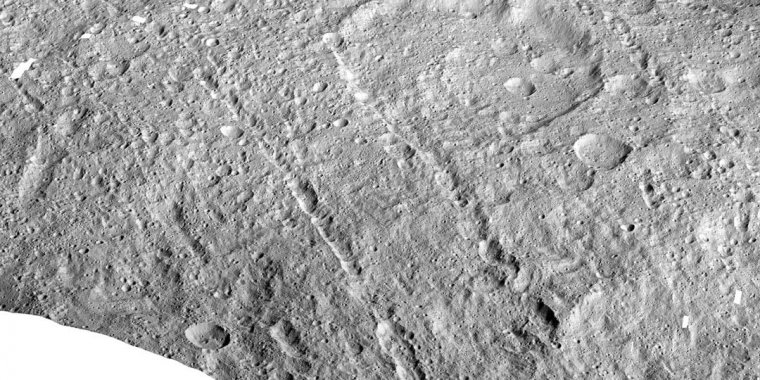| News / Science News |
Dawn Explores Ceres' Interior Evolution
A recent study analyzed Ceres' surface features to reveal clues about the dwarf planet's interior evolution. Specifically, the study explored linear features -- the chains of pits and small, secondary craters common on Ceres.

This image made with data from NASA's Dawn spacecraft shows pit chains on dwarf planet Ceres called Samhain Catenae. ![]()
The findings align with the idea that, hundreds of millions (up to a billion) years ago, materials beneath Ceres' surface pushed upward toward the exterior, creating fractures in the crust.
The indication of upwelling material under Ceres' surface allows for another perspective in establishing how the dwarf planet may have evolved.
Dawn scientists generated a map of over 2,000 linear features on Ceres greater than 0.6 mile (one kilometer) in length that are located outside of impact craters. The scientists interpreted Dawn's observations of two kinds of linear features to further understand their connection to the upwelling material.
Secondary crater chains, the most common of the linear features, are long strings of circular depressions created by fragments thrown out of large impact craters as they formed on Ceres. Pit chains, on the other hand, are surface expressions of subsurface fractures.
The study's greatest challenge was differentiating between secondary crater chains and pit chains. Although the features are strikingly similar, researchers were able to distinguish between them based on their detailed shapes.
For example, secondary craters are comparatively rounder than pit chains, which are more irregular. In addition, pit chains lack raised rims, whereas there is usually a rim around secondary craters.
While it is possible that the freezing of a global subsurface ocean formed the fractures, this scenario is unlikely, as the locations of pit chains are not evenly dispersed across Ceres' surface.
It is also unlikely that the fractures formed by stresses from a large impact because there is no evidence on Ceres of impacts substantial enough to generate fractures of that scale. The most probable explanation is that a region of upwelling material formed the pit chains. The material may have flowed upward from Ceres' interior because it is less dense than surrounding materials. (NASA)
YOU MAY ALSO LIKE




